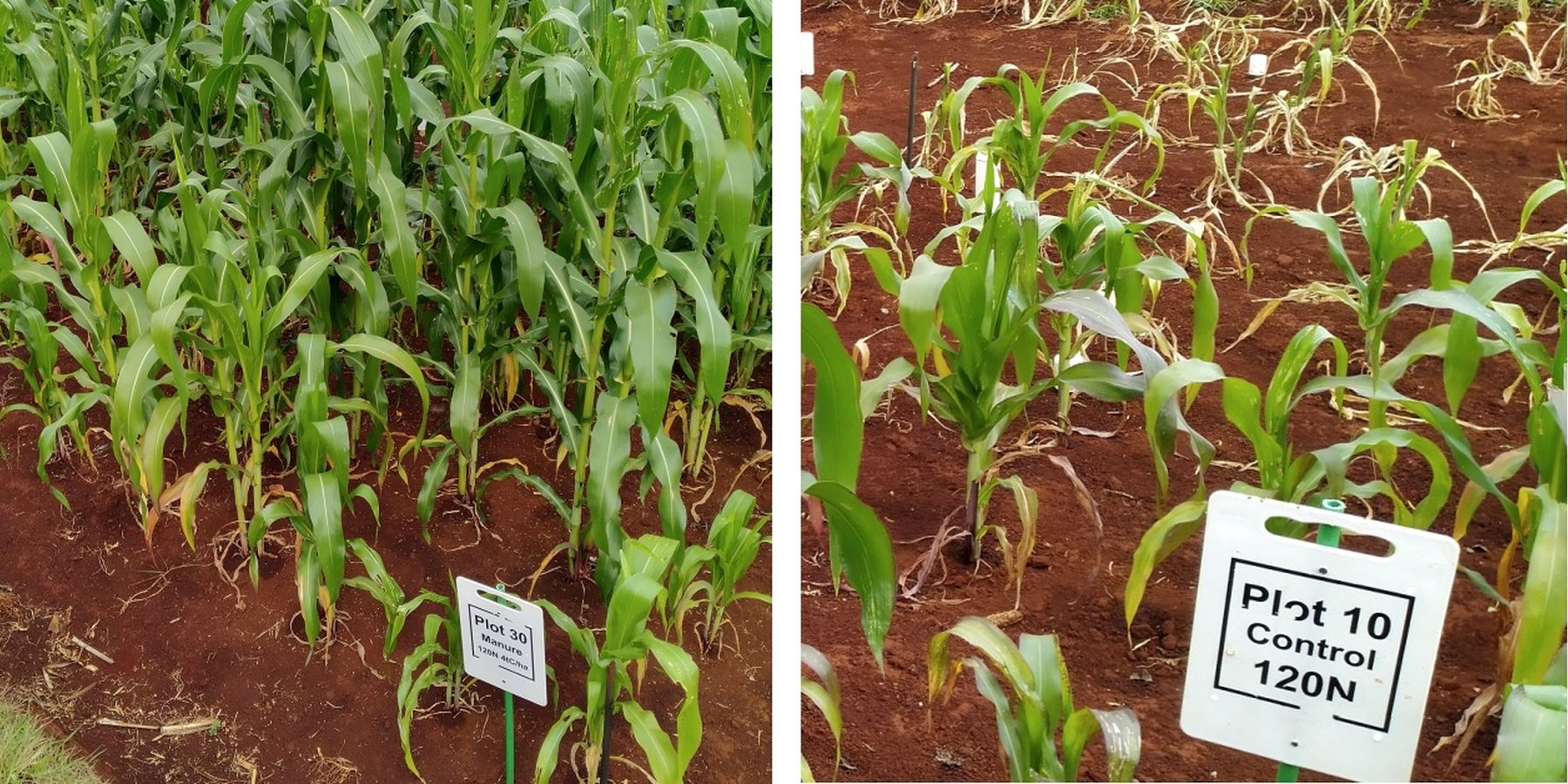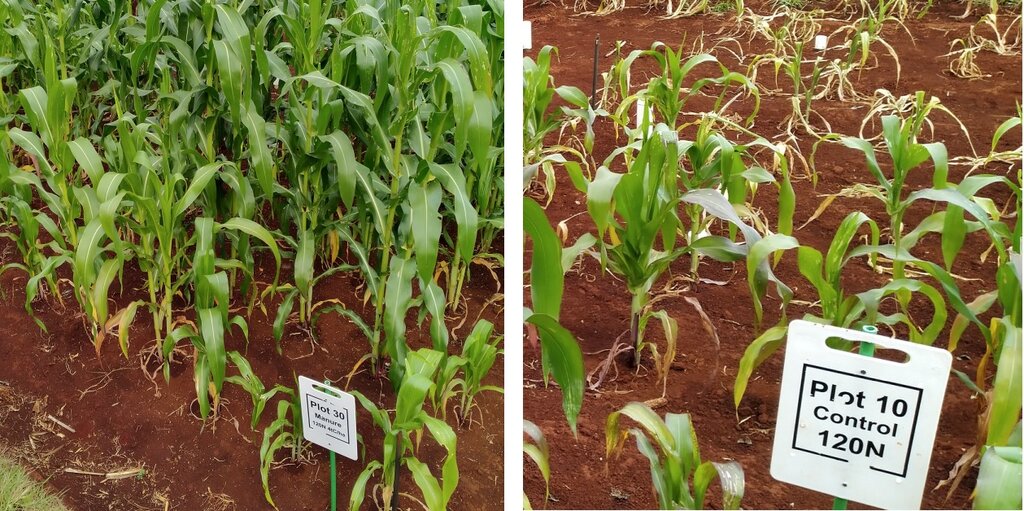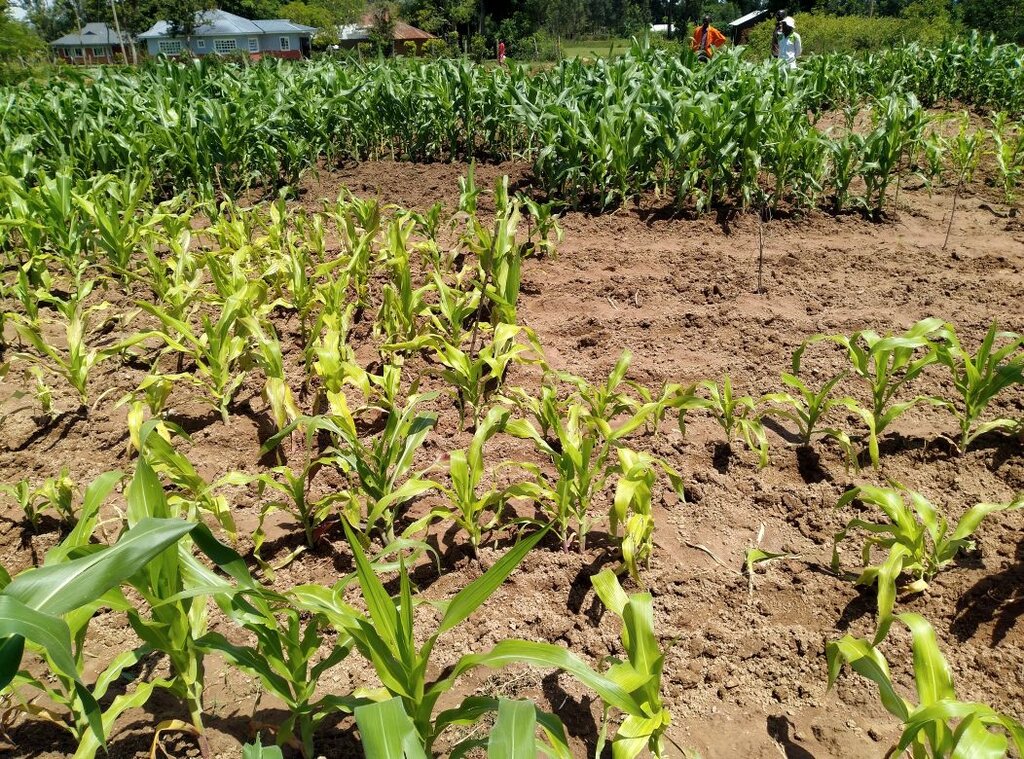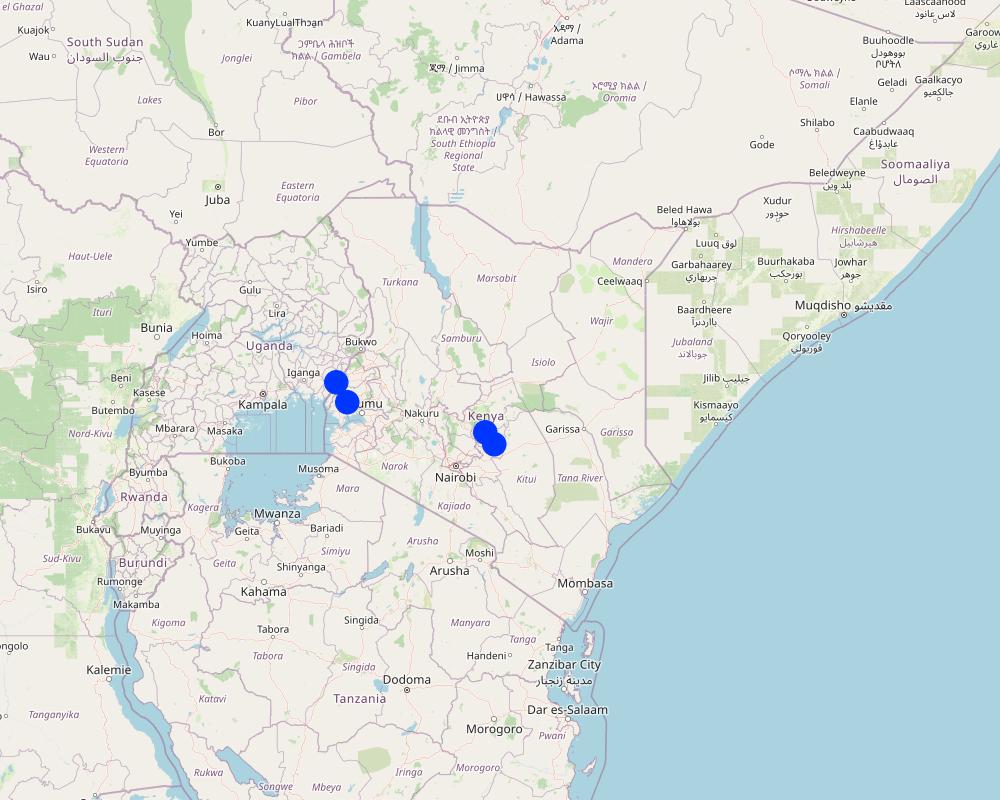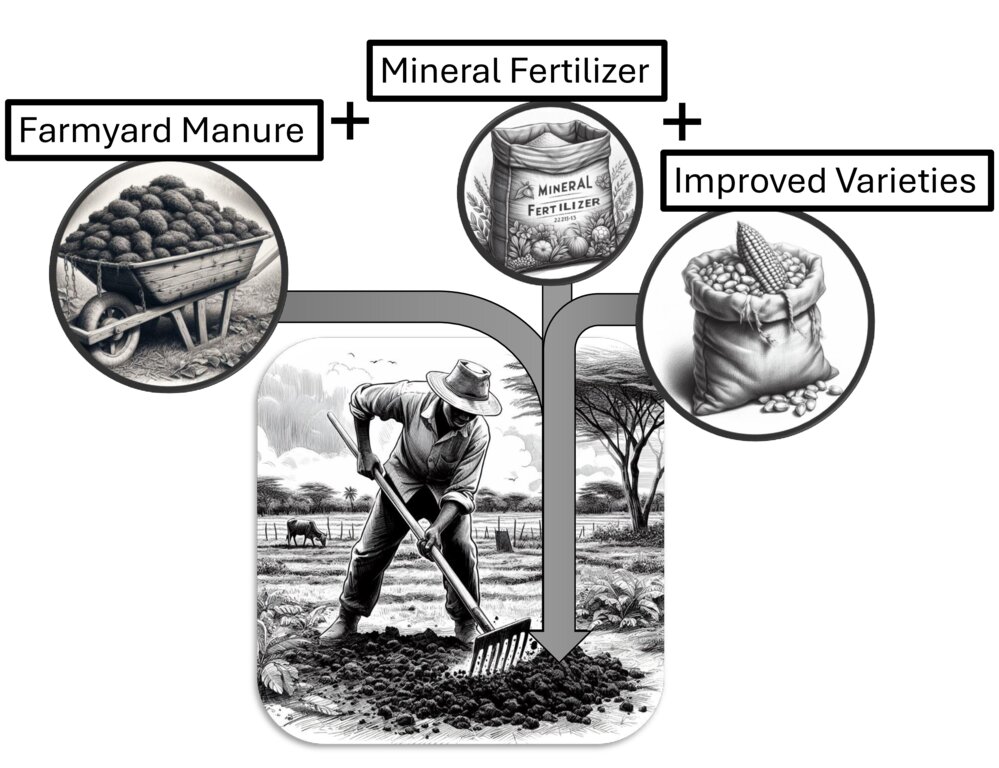Integrated soil fertility management (ISFM) [肯尼亚]
- 创建:
- 更新:
- 编制者: Moritz Laub
- 编辑者: –
- 审查者: William Critchley, Rima Mekdaschi Studer
Machanganyiko ya mbolea ya ngombe na fertilizer
technologies_7121 - 肯尼亚
查看章节
全部展开 全部收起1. 一般信息
1.2 参与该技术评估和文件编制的资源人员和机构的联系方式
关键资源人
SLM专业人员:
Laub Moritz
ETH Zurich
瑞士
SLM专业人员:
Bernhard Vanlauwe
International Institute of Tropical Agriculture
肯尼亚
SLM专业人员:
Six Johan
ETH Zurich
瑞士
SLM专业人员:
Mucheru-Muna Monicah
Kenyatta University
肯尼亚
SLM专业人员:
Yegon Rebecca
University of Embu
肯尼亚
土地使用者:
Waswa Wycliffe
International Institute of Tropical Agriculture
肯尼亚
土地使用者:
Kiragu Silas
University of Embu
肯尼亚
有助于对技术进行记录/评估的项目名称(如相关)
Land Use Based Mitigation for Resilient Climate Pathways (LANDMARC)有助于对技术进行记录/评估的机构名称(如相关)
ETH-Zürich (ETH-Zürich) - 瑞士1.3 关于使用通过WOCAT记录的数据的条件
编制者和关键资源人员接受有关使用通过WOCAT记录数据的条件。:
是
1.4 所述技术的可持续性声明
这里所描述的技术在土地退化方面是否存在问题,导致无法被认为是一种可持续的土地管理技术?:
否
注释:
ISFM offers reduced degradation, or even avoided degradation of soils compared to the locally most used alternative maize growing systems, traditional low-input maize production and high input maize production with only mineral N fertilizer. As demonstrated in four long-term trials, both of these systems usually come at the cost of soil fertility loss.
2. SLM技术的说明
2.1 技术简介
技术定义:
Integrated soil fertility management constitutes a group of management practices aimed at increasing soil fertility and crop productivity with the local context in mind. These practices integrate the use of organic inputs, fertilizers, and better quality seeds with all inputs managed following good farming practices.
2.2 技术的详细说明
说明:
Integrated Soil Fertility Management (ISFM) is applied in arable cropping systems. In this example it was rigorously tested in maize cropping systems in Kenya. The main features of ISFM are the integration of organic inputs to increase or maintain soil fertility and provide a background of nutrient release, with mineral fertilizers to meet peak plant demand together with high quality seeds that can utilize the inputs well. The main objectives are to increase crop yield while maintaining or improving soil fertility. This is important because four long-term trials in Kenya have shown that long-term maize yields decline in both low-input systems and systems with high mineral N inputs but without organic inputs. In contrast, systems with farmyard manure application maintained yields over two decades and maintained significantly higher soil fertility. It has also been shown that the input of organic resources with a low C:N ratio, such as farmyard manure, is more effective in maintaining yields and soil fertility than mineral fertilizer inputs. Thus, the main inputs are organic resources with a low C:N ratio (ideally farmyard manure, but green manures such as Tithonia sp. or Calliandra sp. can also be used), while mineral fertilizers and high quality seeds are also needed. A major activity is the incorporation of organic resources before planting, which requires additional labour. ISFM offers significantly higher yields, and yield maintenance over time, while maintaining or increasing soil fertility. However, it is important to note that the advantage of ISFM over mineral fertilizer use becomes apparent only in the long term (e.g., after 5 to 10 years of continuous cropping). This is because mineral fertilizer inputs may initially mask the loss of soil fertility. This long-term perspective has to be kept in mind when considering the main perceived disadvantage of ISFM - that is the need for manure input and labour for its incorporation, which does not immediately result in higher yields compared to mineral fertilizer application alone.
2.3 技术照片
2.5 已应用该技术的、本评估所涵盖的国家/地区/地点
国家:
肯尼亚
区域/州/省:
Embu County; Siaya County; Busia County
有关地点的进一步说明:
Embu city; Mavuria; close to Siaya; close to Busia
具体说明该技术的分布:
- 适用于特定场所/集中在较小区域
技术现场是否位于永久保护区?:
否
注释:
The locations display the position of the long-term trials in which ISFM was tested
Map
×2.6 实施日期
注明实施年份:
2002
2.7 技术介绍
详细说明该技术是如何引入的:
- 在实验/研究期间
3. SLM技术的分类
3.1 该技术的主要目的
- 改良生产
- 减少、预防、恢复土地退化
- 适应气候变化/极端天气及其影响
- 创造有益的经济影响
3.2 应用该技术的当前土地利用类型
同一土地单元内混合使用的土地::
否

农田
- 一年一作
年作 - 具体指明作物:
- 谷物类 - 玉米
- 谷类 - 小米
- 谷类 - 高粱
年作制度:
连作玉米/高粱/谷子
每年的生长季节数:
- 2
采用间作制度了吗?:
否
采用轮作制度了吗?:
否

其它
具体说明:
Mixed crop-livestock farms
注释:
Manure can come from animals that are grazed or from animals kept in a zero-grazing system.
3.3 由于技术的实施,土地使用是否发生了变化?
由于技术的实施,土地使用是否发生了变化?:
- 否(继续问题3.4)
3.4 供水
该技术所应用土地的供水:
- 雨养
3.5 该技术所属的SLM组
- 农畜综合管理
- 土壤肥力综合管理
- 改良植物品种/动物品种
3.6 包含该技术的可持续土地管理措施

农艺措施
- A2:有机质/土壤肥力
- A5:种子管理,改良品种
- A6:残株管理
A6:对残株管理作出具体说明:
A 6.2:放牧
3.7 该技术强调的主要土地退化类型

化学性土壤退化
- Cn:肥力下降和有机质含量下降(非侵蚀所致)

生物性退化
- Bl:土壤寿命损失
3.8 防止、减少或恢复土地退化
具体数量名该技术与土地退化有关的目标:
- 防止土地退化
- 减少土地退化
4. 技术规范、实施活动、投入和成本
4.1 该技术的技术图纸
技术规范(与技术图纸相关):
Organic resources are distributed equally across the field and then incorporated (usually by hand hoe). Full ISFM integrates this with improved maize varieties and small doses of mineral fertilizer.
作者:
Moritz Laub
日期:
07/05/2024
4.2 有关投入和成本计算的一般信息
具体说明成本和投入是如何计算的:
- 每个技术区域
注明尺寸和面积单位:
hectare
其它/国家货币(具体说明):
KSH
如相关,注明美元与当地货币的汇率(例如1美元=79.9巴西雷亚尔):1美元=:
135.0
注明雇用劳工的每日平均工资成本:
500
4.3 技术建立活动
| 活动 | 时间(季度) | |
|---|---|---|
| 1. | Training on (green/farmyard) manure handling and incorporation | any |
4.4 技术建立所需要的费用和投入
| 对投入进行具体说明 | 单位 | 数量 | 单位成本 | 每项投入的总成本 | 土地使用者承担的成本% | |
|---|---|---|---|---|---|---|
| 其它 | Training on ISFM and organic resource management |
如果土地使用者负担的费用少于100%,请注明由谁负担其余费用:
One or two days of workshop costs. Cost of exchanges with extension agents (mainly time)
4.5 维护/经常性活动
| 活动 | 时间/频率 | |
|---|---|---|
| 1. | Organic resource preparation (e.g. chopping of green manure, farmyard manure management) | Before planting |
| 2. | Organic resource application and incorporation to about 15 cm soil depth | Before planting |
| 3. | Application of mineral fertilizer | During peak demand |
4.6 维护/经常性活动所需要的费用和投入(每年)
| 对投入进行具体说明 | 单位 | 数量 | 单位成本 | 每项投入的总成本 | 土地使用者承担的成本% | |
|---|---|---|---|---|---|---|
| 劳动力 | Manual labor for manure incorporation | labor days per ha | 10.0 | 500.0 | 5000.0 | |
| 植物材料 | Hybrid maize seeds | kg per ha | 25.0 | 450.0 | 11250.0 | |
| 肥料和杀菌剂 | Manure (green/farmyard) per ha and season | t dry matter | 2.0 | 5500.0 | 11000.0 | |
| 肥料和杀菌剂 | Mineral N (estimate ideal input) | kg per ha and season | 30.0 | 300.0 | 9000.0 | |
| 技术维护所需总成本 | 36250.0 | |||||
| 技术维护总成本,美元 | 268.52 | |||||
注释:
Prices of May 2024. The cost of manure is highly variable locally (estimated to be around 2000 KSH per t dry matter in western and up to 9000 KSH per t dry matter in central Kenya; we used the mean value of these). In mixed crop-livestock systems, the manure may be sourced from the own farm, in which case the cost of ISFM may be reduced tremendously.
4.7 影响成本的最重要因素
描述影响成本的最决定性因素:
Local labor prices. Local availability of livestock. Local fertilizer and seed prices.
5. 自然和人文环境
5.1 气候
年降雨量
- < 250毫米
- 251-500毫米
- 501-750毫米
- 751-1,000毫米
- 1,001-1,500毫米
- 1,501-2,000毫米
- 2,001-3,000毫米
- 3,001-4,000毫米
- > 4,000毫米
有关降雨的规范/注释:
ISFM can likely be used wherever it is feasible to grow maize. It proved most effective in high-rainfall areas > 1200 mm (for maize), because in areas where rainfall was limiting (e.g., Machanga site), the plants were mainly water limited and could not make good use of the additional soil fertility.
农业气候带
- 潮湿的
5.2 地形
平均坡度:
- 水平(0-2%)
- 缓降(3-5%)
- 平缓(6-10%)
- 滚坡(11-15%)
- 崎岖(16-30%)
- 陡峭(31-60%)
- 非常陡峭(>60%)
地形:
- 高原/平原
- 山脊
- 山坡
- 山地斜坡
- 麓坡
- 谷底
垂直分布带:
- 0-100 m a.s.l.
- 101-500 m a.s.l.
- 501-1,000 m a.s.l.
- 1,001-1,500 m a.s.l.
- 1,501-2,000 m a.s.l.
- 2,001-2,500 m a.s.l.
- 2,501-3,000 m a.s.l.
- 3,001-4,000 m a.s.l.
- > 4,000 m a.s.l.
说明该技术是否专门应用于:
- 不相关
5.3 土壤
平均土层深度:
- 非常浅(0-20厘米)
- 浅(21-50厘米)
- 中等深度(51-80厘米)
- 深(81-120厘米)
- 非常深(> 120厘米)
土壤质地(表土):
- 中粒(壤土、粉土)
- 细粒/重质(粘土)
土壤质地(地表以下> 20厘米):
- 中粒(壤土、粉土)
- 细粒/重质(粘土)
表土有机质:
- 中(1-3%)
- 低(<1%)
如有可能,附上完整的土壤描述或具体说明可用的信息,例如土壤类型、土壤酸碱度、阳离子交换能力、氮、盐度等。:
Detailed descriptions can be found here: https://www.sciencedirect.com/science/article/pii/S0378429022003598
and here: https://soil.copernicus.org/articles/9/301/2023/
5.4 水资源可用性和质量
地表水的可用性:
中等
水质(未处理):
仅供农业使用(灌溉)
水质请参考::
地表水
水的盐度有问题吗?:
否
该区域正在发生洪水吗?:
否
5.5 生物多样性
物种多样性:
- 中等
栖息地多样性:
- 中等
5.6 应用该技术的土地使用者的特征
定栖或游牧:
- 定栖的
生产系统的市场定位:
- 混合(生计/商业)
非农收入:
- 低于全部收入的10%
相对财富水平:
- 贫瘠
- 平均水平
个人或集体:
- 个人/家庭
机械化水平:
- 手工作业
- 畜力牵引
土地使用者的年龄:
- 中年人
5.7 应用该技术的土地使用者使用的平均土地面积
- < 0.5 公顷
- 0.5-1 公顷
- 1-2 公顷
- 2-5公顷
- 5-15公顷
- 15-50公顷
- 50-100公顷
- 100-500公顷
- 500-1,000公顷
- 1,000-10,000公顷
- > 10,000公顷
这被认为是小规模、中规模还是大规模的(参照当地实际情况)?:
- 中等规模的
5.8 土地所有权、土地使用权和水使用权
土地所有权:
- 个人,未命名
- 个人,有命名
土地使用权:
- 个人
5.9 进入服务和基础设施的通道
健康:
- 贫瘠
- 适度的
- 好
教育:
- 贫瘠
- 适度的
- 好
技术援助:
- 贫瘠
- 适度的
- 好
就业(例如非农):
- 贫瘠
- 适度的
- 好
市场:
- 贫瘠
- 适度的
- 好
能源:
- 贫瘠
- 适度的
- 好
道路和交通:
- 贫瘠
- 适度的
- 好
饮用水和卫生设施:
- 贫瘠
- 适度的
- 好
金融服务:
- 贫瘠
- 适度的
- 好
6. 影响和结论性说明
6.1 该技术的现场影响
社会经济效应
生产
作物生产
SLM之前的数量:
1-2 t maize grain yield per ha and season
SLM之后的数量:
3-4 t maize grain yield per ha and season
注释/具体说明:
The presented yield values are measured data from long-term experiments. They represent the average across all sites.
See https://www.sciencedirect.com/science/article/pii/S0378429022003598 for details
收入和成本
农业投入费用
农业收入
工作量
生态影响
土壤
养分循环/补给
土壤有机物/地下C
SLM之前的数量:
Annual decline of about 2% of initial SOM
SLM之后的数量:
Annual decline reduced to about 0.5% of initial SOM
注释/具体说明:
The presented soil organic carbon values are measured data from long-term experiments. They represent the average across all sites.The general loosing trajectory was a function of the sites being relatively newly established. In sites with low SOM, an increase is possible. Details in https://soil.copernicus.org/articles/9/301/2023/
酸度
SLM之前的数量:
pH around 5
SLM之后的数量:
pH around 6
注释/具体说明:
The presented soil pH values are measured data from long-term experiments. They represent the average across all sites.Comparison between the control and farmyard manure treatments. Details in https://soil.copernicus.org/articles/9/301/2023/
6.2 该技术的场外影响已经显现
温室气体的影响
SLM之前的数量:
about 2.5 kg CO2-eq emissions per kg of maize grain yield
SLM之后的数量:
about 1.5 kg CO2-eq emissions per kg of maize grain yield
注释/具体说明:
Note that GHG values are expressed in terms of emissions per yield.
6.3 技术对渐变气候以及与气候相关的极端情况/灾害的暴露和敏感性(土地使用者认为的极端情况/灾害)
渐变气候
渐变气候
| 季节 | 增加或减少 | 该技术是如何应对的? | |
|---|---|---|---|
| 年温度 | 增加 | 适度 |
气候有关的极端情况(灾害)
气象灾害
| 该技术是如何应对的? | |
|---|---|
| 局地暴雨 | 适度 |
气候灾害
| 该技术是如何应对的? | |
|---|---|
| 干旱 | 不好 |
注释:
In areas with abundant rainfall (1500 mm per year and more, as in western Kenya) the maize under ISFM did not struggle under increased temperatures. In areas with only 1200 mm (such as in central Kenya) and lower rainfall, the maize suffered severely in drier seasons, even under ISFM.
6.4 成本效益分析
技术收益与技术建立成本相比如何(从土地使用者的角度看)?
短期回报:
消极
长期回报:
积极
技术收益与技术维护成本/经常性成本相比如何(从土地使用者的角度看)?
短期回报:
轻度消极
长期回报:
稍微积极
6.5 技术采用
- 11-50%
如若可行,进行量化(住户数量和/或覆盖面积):
Estimated to be around 20-25% both in Western and central Kenya. Currently increased uptake, mainly due to surges in mineral fertilizer prices.
在所有采用这项技术的人当中,有多少人是自发的,即未获得任何物质奖励/付款?:
- 51-90%
注释:
There are no government incentives to apply organic resources to the soil.
6.6 适应
最近是否对该技术进行了修改以适应不断变化的条件?:
是
若是,说明它适应了哪些变化的条件:
- 气候变化/极端气候
具体说明技术的适应性(设计、材料/品种等):
The trials have been redesigned for intercropping with the MBILI system - results are expected in 2027/8. (Details on MBILI: https://www.sciencedirect.com/science/article/pii/S0378429009002809)
6.7 该技术的优点/长处/机会
| 土地使用者眼中的长处/优势/机会 |
|---|
| Maintenance of crop yields in integrated crop-livestock systems. |
| 编制者或其他关键资源人员认为的长处/优势/机会 |
|---|
| Maintaining soil fertility as the basis of crop production and sustained yields. |
6.8 技术的弱点/缺点/风险及其克服方法
| 土地使用者认为的弱点/缺点/风险 | 如何克服它们? |
|---|---|
| Advantage compared to mineral fertilizer use not directly visible. | Demonstration on the sites. Farmers training. Farmers trials. |
| 编制者或其他关键资源人员认为的弱点/缺点/风险 | 如何克服它们? |
|---|---|
| Scarcity of organic inputs. Maintaining SOM requires very high input rates. | Combining ISFM with improved inter-cropping systems. Research is currently ongoing. |
7. 参考和链接
7.1 信息的方法/来源
- 与土地使用者的访谈
Several exchanges with local farmers and extension agents on ISFM specific workshops. Exchanges with long-term trial managers
- 与SLM专业人员/专家的访谈
Several exchanges with experts involved in the long-term trials.
- 根据报告和其他现有文档进行编译
Several scientific publications (are given where used)
(现场)数据是什么时候汇编的?:
20/07/2023
7.2 参考可用出版物
标题、作者、年份、ISBN:
Laub, M., Corbeels, M., Mathu Ndungu, S., Mucheru-Muna, M.W., Mugendi, D., Necpalova, M., Van de Broek, M., Waswa, W., Vanlauwe, B., Six, J., 2023. Combining manure with mineral N fertilizer maintains maize yields: Evidence from four long-term experiments in Kenya. Field Crops Research 291, 108788.
可以从哪里获得?成本如何?
For free at: https://doi.org/10.1016/j.fcr.2022.108788
标题、作者、年份、ISBN:
Laub, M., Corbeels, M., Couëdel, A., Ndungu, S.M., Mucheru-Muna, M.W., Mugendi, D., Necpalova, M., Waswa, W., Van de Broek, M., Vanlauwe, B., Six, J., 2023. Managing soil organic carbon in tropical agroecosystems: evidence from four long-term experiments in Kenya. SOIL 9, 301–323.
可以从哪里获得?成本如何?
For free at: https://doi.org/10.5194/soil-9-301-2023
标题、作者、年份、ISBN:
Mucheru-Muna, M., Pypers, P., Mugendi, D., Kung’u, J., Mugwe, J., Merckx, R., Vanlauwe, B., 2010. A staggered maize–legume intercrop arrangement robustly increases crop yields and economic returns in the highlands of Central Kenya. Field Crops Research 115, 132–139.
可以从哪里获得?成本如何?
https://doi.org/10.1016/j.fcr.2009.10.013
7.3 链接到网络上的相关信息
标题/说明:
Article on yield development in ISFM
URL:
https://doi.org/10.1016/j.fcr.2022.108788
标题/说明:
Article on soil organic matter development in ISFM
URL:
https://doi.org/10.5194/soil-9-301-2023
7.4 一般注释
Very detailed inputs required. Filled out to the best of my knowledge.
Only qualitative reports about economics at farm level were available. Measurements will be conducted in an upcoming project
链接和模块
全部展开 全部收起链接
无链接
模块
无模块


